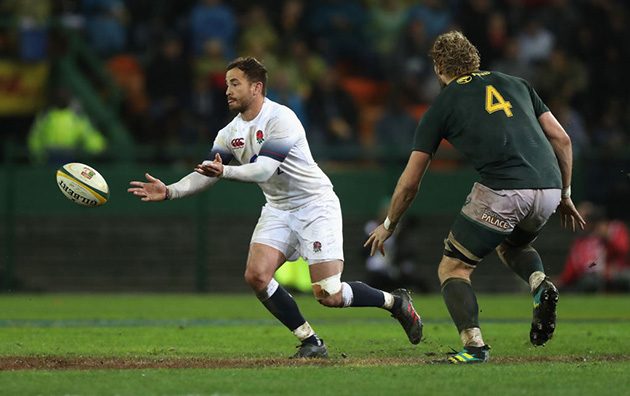From Danny Cipriani to the All Blacks’ next generation, Paul Williams reflects on the final weekend of summer tours action
Danny Cipriani took his chance
Anyone with even an ounce of rugby romanticism left in their cold modern-rugby hearts was hoping Danny Cipriani would take his England opportunity with both hands in Cape Town.
Ideally, he would take it with both hands, step two defenders and then rip a miss-two spiral pass out to Jonny May. But when the opportunity came, Cipriani actually took it with one foot. It was a truly beautiful kick-through, squeezed between two defenders. Threading the needle doesn’t quite do it justice; this was like threading the Large Hadron Collider.
What a kick by @DannyCipriani87 to set up Jonny May and secure @EnglandRugby win in South Africa! #RSAvENG https://t.co/DjKt0aCwda
— Sky Sports Rugby (@SkySportsRugby) June 23, 2018
The kick was even more impressive as it was the only chance he had to impress during the game. With the pitch wet enough to cultivate basmati and Eddie Jones not giving him the chance to take restarts, kicks at goal or line kicks, the odds were stacked against Cipriani doing the business. But do it he did.
That kick – and the resulting try from the increasingly immaculate Jonny May – have saved Mr Jones a lot of grief over the summer.
No rule for referee blocking – but we need one
The third Test between the All Blacks and France once again witnessed an unusual decision given by the referee. Although this instance was very different to the first two Tests.
For a start, it was the referee who was involved and secondly, whilst the decision looked incorrect, by the letter of the law it was bang on the money.

Stop sign: Baptiste Serin is blocked by the referee as Aaron Smith passes to Damian McKenzie (Getty Images)
John Lacey blocked Baptiste Serin and stopped him making a tackle, which led directly to a try for New Zealand. While no specific law outlines this issue, rugby supporters all over the world have witnessed referees bringing back play when they have accidently blocked a tackler.
What’s even more peculiar is that in a book of laws where interpretation is renowned, an incident like this can be viewed as being clear-cut. But perhaps most perplexing is that if the blocking player had been from the attacking team, and not the referee, it would have been an instant penalty.
Ireland are the envy of the northern hemisphere
Ireland have ticked so many boxes during the past 12 months that there can’t be a usable pen remaining at the IRFU. But the series win over the Wallabies surely ranks above them all and places them as arguably the only team who can realistically challenge the All Blacks in 2019.
Series wins in Australia are as rare as emotions in the Trump administration. Some may argue that this Wallaby squad is 18 months away from its best, but it has proven to be a very competitive team and hugely improved from 24 months ago.

Green machine: Ireland celebrate winning the Test series against Australia (Getty Images)
This a Wallaby pack weighing over 910kg, with two legitimate sets of front-row forwards, two of the best opensides in the world and arguably the best back-line outside of New Zealand.
To have won the series, after losing the first Test, whilst still achieving a degree of squad rotation, is a fantastic achievement. This current squad has the perfect profile for a World Cup in 2019, with a rock-solid senior spine and some youthful limbs that have 15 months still to flourish; they are where many thought England would be.
Scotland shred Argentina
Those looking for Saturday-night entertainment should have shunned Love Island, which I have now become addicted to thanks to Ugo Monye, and flicked on the Scotland game.
It was a stunning example of offloading and simple running angles. There were occasions where the Scottish back-line looked like they were playing unopposed and that the Pumas defenders should have been wearing bibs.

Livewire: George Horne breaks for Scotland against Argentina (Getty Images)
Scotland made 20 clean breaks, Stuart Hogg and George Horne making four each and Adam Hastings and Dougie Fife with three apiece. But it was the variation in creativity that was so appealing.
Some were scrum-half snipes, others accurate chips over the top and the rest Pythagoras-like angles through the centre. All made more remarkable by the conditions – it was soaking wet.
Scotland may have lost to the USA, but this tour has been a success. Gregor Townsend now has a genuine Test squad, with depth in key positions. Something that, like Wales, they haven’t had since the game went pro.
Big legal hits are possible
This year’s club and Test fixtures have been dominated by high tackles, or more precisely the debate as to what constitutes a high tackle. The debate is nowhere near resolution, but the fear persists that it will lead to big hits being taken from the sport. Though quite how anyone can think the game has gone soft when you see modern-day ruck cleanouts is brain bending.

Size differential: Faf de Klerk tackles Nathan Hughes (Getty Images)
However, two tackles from the Wallabies v Ireland game and one from the South Africa v England fixture proved that big hits can still be head and shoulders above the rest, without anyone’s head being removed from their shoulders.
Both Samu Kerevi and Lukhan Tui delivered textbook tackles without being anywhere near the shoulders of the attacking player. Kerevi’s tackle on Johnny Sexton was two-fold in its impact: it put Sexton on the floor and also stopped him talking to the ref for about 15 seconds, which was a remarkable achievement. Although it must be said, the hit did nothing to halt another complete performance from the best ten in the world currently.
The largest round of applause has to go to Faf de Klerk for his tackle on Nathan Hughes. It was like watching David fell Goliath, if David had just stepped out of a 1990s L’Oréal advert.
The game hasn’t gone soft, it has just gone less dangerous. There’s a big difference.
Pumas are playing Super Rugby at Test level – and it’s not working
Super Rugby is the most entertaining form of the sport. The quality of handling and finishing is the benchmark for the global game. And it would be foolish to suggest that Super Rugby doesn’t produce Test-ready players. It clearly does, just look at New Zealand.
However, the Super Rugby approach isn’t the correct strategy for Test rugby. When the Kiwi players run out for the All Blacks, they are not using a Super Rugby blueprint. At the moment, the Jaguares are.

Looking for space: Gonzalo Bertranou tries to spark an attack for Argentina (Getty Images)
Having a single club team as the basis of your Test team has many positives and the Jaguares have been playing well in their league, but the Pumas Test form is a concern.
Second teams from Wales and Scotland have pumped the Pumas at home. Their forward platform and defence is currently non-existent. The desire to go wide, immediately and at all costs, has replaced what was once the staple of Argentinian Rugby. World Cup semi-finals look like a distance dream for the current Pumas, and their football team for that matter.
The All Blacks’ new generation impress
The All Black’s performance in the third Test against France was so complete that it is easy to forget that this was an experimental line-up from New Zealand. During this summer’s tours everyone has been aware that Scotland, Wales, South Africa and Ireland (to an extent) have rotated squads and experimented, but that same level of appreciation hasn’t really been forthcoming for the All Blacks.

First run: Jack Goodhue made his New Zealand debut against France (Getty Images)
Controversial refereeing decisions in the first two Tests may have neutered the rugby-watching public’s appreciation for the All Blacks’ next generation line-up, but the reality is that New Zealand played the third Test with a very experimental team. And what a performance it was.
An entirely new back row, a rarely tested combination at nine and ten, and a new partnership at centre stuck 49 points on a hitherto competitive France.
Whilst the third Test once again had another refereeing decision seemingly Brexit-like in its logic, it did not decide the game. There were no yellow or red cards to blame for the Kiwis’ seven tries, no official can be blamed for Damian McKenzie carrying 92 metres from outside-half (a ridiculous number for a ten) and no referee ensured that the French back-line only managed four clean breaks in 80 minutes.
The next generation of All Blacks look as good as the current lot, and that’s a worry for the rest.
Follow Rugby World on Facebook, Twitter and Instagram.





